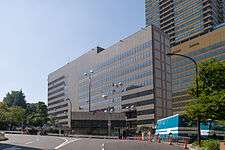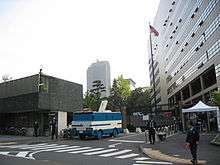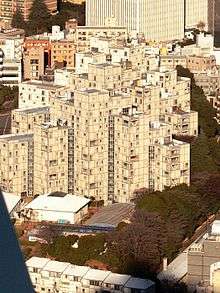Embassy of the United States, Tokyo
| Embassy of the United States in Tokyo 駐日アメリカ合衆国大使館  | |
|---|---|
 | |
| Location | 1-10-5 Akasaka, Minato, Tokyo 107-8420, Japan |
| Coordinates | 35°40′07″N 139°44′36″E / 35.66861°N 139.74328°ECoordinates: 35°40′07″N 139°44′36″E / 35.66861°N 139.74328°E |
| Ambassador | William F. Hagerty |
The Embassy of the United States in Tokyo represents the United States in Tokyo, Japan. Along with consulates in Osaka, Nagoya, Sapporo, Fukuoka, and Naha, the Embassy provides assistance to American citizens and residents who live in Japan and issues visas to Japanese nationals, and legal residents in Japan who wish to visit or immigrate to the United States.
William F. Hagerty, the current Ambassador to Japan, was sworn in on July 27, 2017.[1][2]
Jason P. Hyland became Deputy Chief of Mission, U.S. Embassy Tokyo in July 2014. Hyland became Chargé d'Affaires ad interim upon former ambassador Caroline Kennedy's departure on January 18, 2017.
The current embassy building was designed by César Pelli and Norma Merrick Sklarek and completed in 1976.
Location


.jpg)
The embassy is located in the Akasaka neighborhood of Minato, Tokyo, steps away from the Nagatachō district, home of the Japanese legislature and the Prime Minister's residence. The address is 1-10-5, Akasaka, Minato-ku Post Code: 107-8420.[3] It is easily accessible via the Tokyo Metro Ginza or Namboku Lines Tameike-Sannō Station and conveniently located to the Hotel Okura.
History
Previous US missions in Japan
The first American consulate in Japan was opened at the temple of Gyokusen-ji, Shimoda, Shizuoka under Consul General Townsend Harris. Gyokusen-ji is also the location of a small number of foreign graves dating from as early as 1854 marking the final resting place of US forces personnel that died while serving as part of Commodore Matthew Perry's 'Black Ship' fleet.
Harris negotiated the Treaty of Amity and Commerce between the two countries, which was signed at nearby Ryōsen-ji in 1858.
The United States established its first legation in Tokyo in 1859 under Townsend Harris. This legation was located at Zenpukuji, a Buddhist temple in the Motoazabu neighborhood of southern Tokyo.
In 1875, the legation was moved to a site on the Sumida River near Tsukiji, in an area slated as a district for foreigners outside the employ of the Japanese government; this site is now occupied by the St. Luke's Garden complex.
The legation moved to the current embassy site in 1890.[4]
In January 1906, following Japan's victory in the Russo-Japanese War, Japan and the U.S. mutually elevated their legates to the rank of ambassador. Several European powers did so at the same time, indicating a perception of equality between Japan and the major Western powers.[5]
World War II
The U.S. Embassy was closed shortly following the Pearl Harbor attack on December 8, 1941. Its American employees (including military attaches) were interned on the embassy grounds until June 1942, when they were sent by ship to Portuguese East Africa and handed over for repatriation.[6] Simultaneously, Japanese diplomats who had been in U.S. were handed over for repatriation.[7]
The U.S. Embassy remained closed during the Allied occupation, as the U.S. was the occupying power in Japan. Following restoration of diplomatic relations under the Treaty of San Francisco, the U.S. Embassy reopened on April 28, 1952.[8] Robert D. Murphy arrived to serve as the American ambassador.[9] The Embassy of Japan in Washington, D.C. also reopened on the same day.[10]
Rent payment issue
The land on which the embassy sits is about 13,000 m² (3.21 acres), and has been leased from the Japanese government since 1896. In 2005, it was reported that the US government had made no payments for the embassy's premises since 1998 after failing to agree on a renewal of the lease agreement.[11] In 2007, the two governments agreed to renew the lease through 2027, following which the US government paid its unpaid rent. The annual rent for the underlying land was set at 7 million yen for 1998-2007, 10 million yen for 2008-12, and 15 million yen for 2013-27. The very low rent amount for the land is due to the age of the lease agreement, and the fact that it originally contained no escalation or adjustment provisions.[12]
U.S. Consulates in Japan
- U.S. Consulate General Naha (Urasoe, Okinawa)
- U.S. Consulate General Osaka-Kobe (Osaka City, Osaka)
- U.S. Consulate General Sapporo (Sapporo, Hokkaido)
- U.S. Consulate Fukuoka (Fukuoka City, Fukuoka)
- U.S. Consulate Nagoya (Nagoya, Aichi)
See also
References
- ↑ "President Donald J. Trump Sends Nominations to the Senate" (Press release). White House Office of the Press Secretary. 2017-03-27. Retrieved 2017-06-04.
- ↑ The White House (2017-07-27), Vice President Pence Swears In U.S. Ambassador to Japan William F. Hagerty IV, retrieved 2017-07-27
- ↑ http://www.pacificprime.com/countries/japan/embassies.php#U Archived 2008-08-20 at the Wayback Machine.
- ↑ http://navi.ag-aoyama.com/14206legationmemorial.htm
- ↑ "Archived copy". Archived from the original on 2007-09-30. Retrieved 2009-05-17.
- ↑ Henri Smith-Hutton, "American Prisoners in Japan," in Paul Stillwell, Air raid, Pearl Harbor! (Naval Institute Press, 1981)
- ↑ "10 From D.C. to Be Traded for Jap Nationals". The Washington Post. 20 June 1942. p. 3.
- ↑ "Foreign Relations of the United States Theme: Reopening the U.S. Embassy in Japan After World War II: Years February 1951 – April 1952". Office of the Historian. United States Department of State. Archived from the original on 8 July 2010.
- ↑ "Japanese Assume New Sovereignty: Little Fanfare Marks Shift From Occupied Status -- Murphy Arrives as U. S. Envoy". The New York Times. 29 April 1952. p. 3.
- ↑ "Japan's Return". The Washington Post. 29 April 1952. p. 12.
- ↑ Takahara, Kanako (2005-10-01). "U.S. eight years behind on rent for embassy". The Japan Times Online. ISSN 0447-5763. Retrieved 2017-01-05.
- ↑ "米国大使館 10年ぶり借地料支払う 日本側値上げに合意". Mainichi Shimbun. 2007-12-11 – via easygoing village (blog).
External links
- tokyo.usembassy.gov United States Embassy in Tokyo, Japan